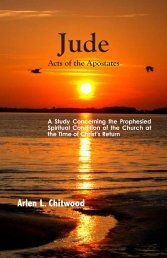Signs in John's Gospel - The Lamp Broadcast
Signs in John's Gospel - The Lamp Broadcast
Signs in John's Gospel - The Lamp Broadcast
You also want an ePaper? Increase the reach of your titles
YUMPU automatically turns print PDFs into web optimized ePapers that Google loves.
Purpose for John’s <strong>Gospel</strong> 5<br />
(Some expositors over the years have sought to date John’s gospel<br />
as early as 45 A.D., though most today contend for a much later date<br />
— closer to 90 A.D. However, with its structure and stated purpose,<br />
writ<strong>in</strong>g the gospel at a time follow<strong>in</strong>g the close of the reoffer of the<br />
k<strong>in</strong>gdom to Israel could not possibly be correct. And there is really no<br />
valid reason for assign<strong>in</strong>g a late date to John’s gospel.<br />
<strong>The</strong> subject matter and content of John’s gospel, of necessity,<br />
places the writ<strong>in</strong>g sometime prior to about 62 A.D. Note the prevalence<br />
of “signs” <strong>in</strong> the Book of Acts, which historically covers the period<br />
dur<strong>in</strong>g which the k<strong>in</strong>gdom was reoffered to Israel, from 33 A.D. to<br />
about 62 A.D. [cf. 2:43; 5:12-16; 6:8; 8:6-8; 9:36-41; 14:3, 8-18; 15:12; 19:11,<br />
12; 20:9-12; 28:3-9].)<br />
Also, view<strong>in</strong>g John’s gospel <strong>in</strong> its correct sett<strong>in</strong>g — call<strong>in</strong>g<br />
specific attention to eight previously performed signs, signs now directed<br />
to Israel dur<strong>in</strong>g a time when the k<strong>in</strong>gdom was be<strong>in</strong>g reoffered<br />
to the nation — will, for the most part, do away with the numerous<br />
textual problems which often surface through view<strong>in</strong>g the gospel<br />
<strong>in</strong> an <strong>in</strong>correct sett<strong>in</strong>g. <strong>The</strong> eight signs, form<strong>in</strong>g a framework<br />
around which this gospel was structured, were recorded for a<br />
stated purpose. And that purpose, as previously shown, clearly<br />
had to do with Israel and the k<strong>in</strong>gdom, not with salvation by<br />
grace (as is so often erroneously read <strong>in</strong>to the text). Ignor<strong>in</strong>g<br />
this fact and read<strong>in</strong>g salvation by grace <strong>in</strong>to John 20:30, 31 can<br />
only result <strong>in</strong> confusion when seek<strong>in</strong>g to properly understand different<br />
parts of John’s gospel.<br />
<strong>The</strong> record<strong>in</strong>g of past events, form<strong>in</strong>g John’s gospel, as previously<br />
stated, was directed to a people who were already saved (as<br />
were the events when they had previously occurred dur<strong>in</strong>g the<br />
orig<strong>in</strong>al offer of the k<strong>in</strong>gdom). It is exactly the same message proclaimed<br />
to the same people, at a later time, referenc<strong>in</strong>g the same signs<br />
previously performed.<br />
An offer of this nature could never be extended to the unsaved.<br />
<strong>The</strong> unsaved are <strong>in</strong> no position to be the recipients of such an offer.<br />
That is to say, spiritually dead people could never be expected to<br />
understand that which is spiritual, deal<strong>in</strong>g with life (i.e., the th<strong>in</strong>gs<br />
to which these “signs” po<strong>in</strong>ted), whether recorded <strong>in</strong> the four<br />
gospels or <strong>in</strong> the Book of Acts (I Cor. 2:9-14).



